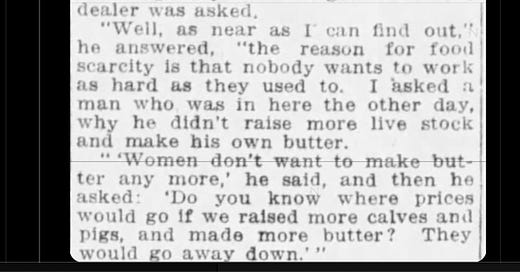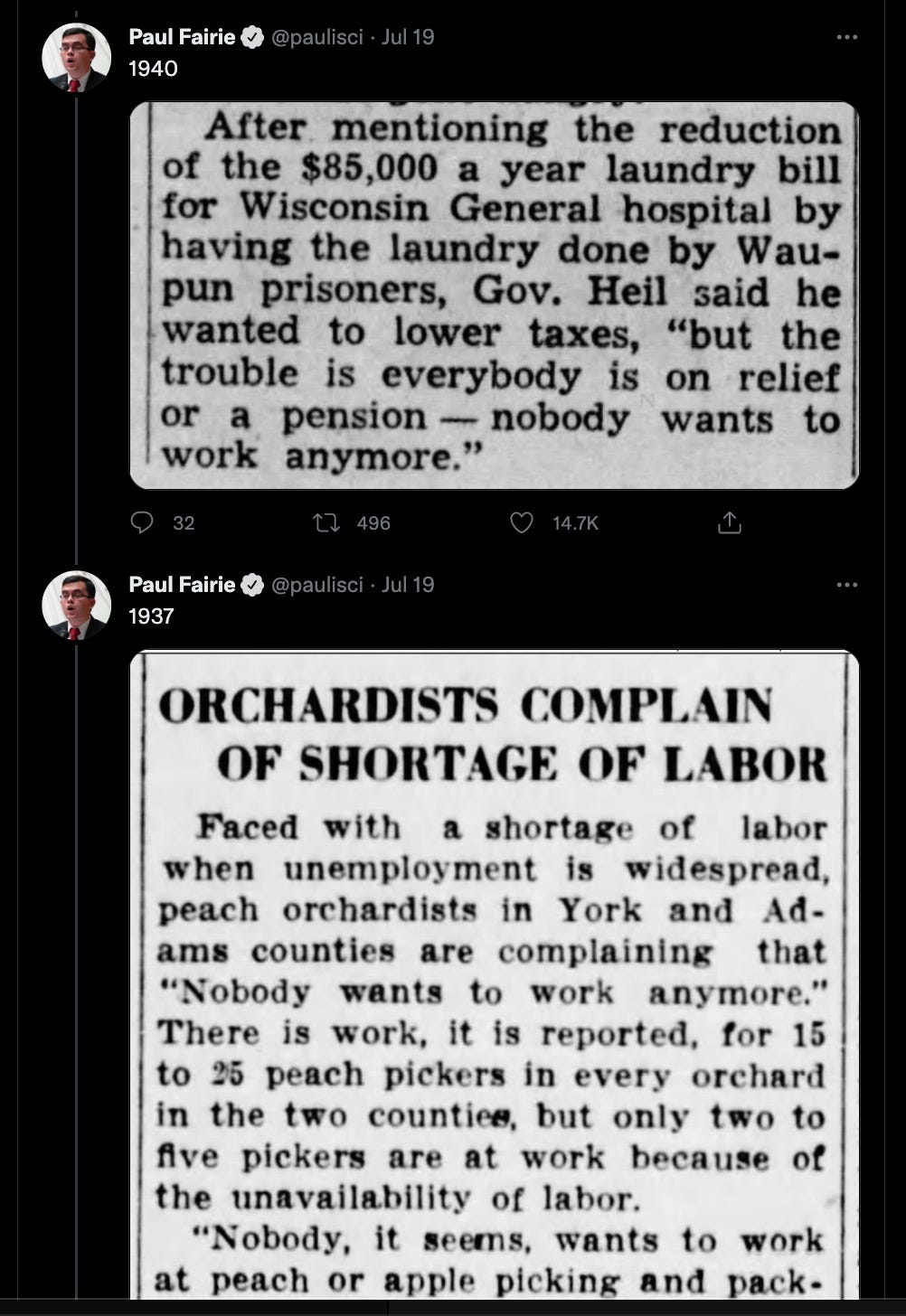"Nobody wants to work anymore"
Prime Future 116: the newsletter for innovators in livestock, meat, and dairy
“In 1930, the lauded economist John Maynard Keynes predicted that—due to productivity increases through technological advancements—the American workweek would shrink to just 15 hours by 2030. Decades later, a 1965 Senate committee said “nah, sooner”— and predicted that we’d be toiling just 14 hours a week by 2000.”
I lol'd when I read this paragraph in Morning Brew.
Keynes, Congress and even Tim Ferris (author of the 4 hour work week) seem to have miscalculated.
It's Labor Day in the US so it seems timely to revisit what's happening in the world of recruiting, hiring, and keeping talent, particularly in production and processing.
Here are a few miscellaneous ways employers are still rethinking all the work things in the current environment:
(1) Tyson has announced multiple experiments rethinking shift scheduling and other benefits to recruit & keep people at plants. From piloting flexible hours while still receiving full-time benefits to providing childcare, to building an "employee well-being center" at one plant. This is, um, not pre-2020 normal packer behavior.
(2) Starbucks is rethinking its store layout to reduce labor demand and labor strain, aka to make it easier to make that skinny vanilla latte which has the added benefit of making it faster for the customer to receive their order. What's good for the person doing the work is good for the person paying for the work to be done? Interesting…
The Starbucks example doesn't fit into the category of livestock production and processing but it does raise an interesting question of how facility designs might change in the future as another lever to pull in the labor equation.
(3) It’s an n of 1, but there was even a story about a farmer rethinking what they produce because of limited access to labor, shifting from labor-intensive dairy to labor-light cow-calf production. While there's likely more to that story than labor, it does go to show how central this labor issue can be to business models that work, or don’t.
(4) And then, of course, there are all the announcements around investment in automation CapEx projects at processing plants to reduce, or at least shift, labor. No surprise here as cost and availability of labor are making automation investments pencil out in a way that they would not have even a couple of years ago, particularly in beef plants where higher carcass variability, compared to poultry or even pork, has long been the reason for less automation.
It seems like almost everyone is rethinking almost everything about how work gets done.
I recognize that humans are incredibly complex in their decision-making about where to work, how much to work, what their next best alternative is, etc.
And yet, I still wonder if when employers say they can't find people to work, what they are really saying is "I can't find people to work at the price I'm willing to pay."
Markets don't lie, ya know? Including labor markets.
Few things get under my skin like when people complain about ‘kids these days’ or the equivalent, sometimes it sounds like “nobody wants to work anymore”. Maybe it’s human nature to do that, or maybe we humans are not only bad at predicting the future but at contextualizing the reality of the past…
I hiiiiighly recommend scrolling through that Twitter thread but here are the punch lines…let’s just say the complaint ‘nobody wants to work anymore’ is not a new thing:
What an ironic time to be alive 😉
ICYMI Prime Future 75 (link)
Nobody knows how the future of work will work.
There is no such thing as “The Cattle Market”. There is a price for live cattle futures contracts, or this week’s average price of bred heifers at the local sale barn, or the average price of feeder calves at Oklahoma City in a specific week. We could go on and on with specific sub-markets across regions and categories, none of which are “The Cattle Market”. Markets are local and specific…also true for labor.
“The Labor Market” isn’t a real thing.
Labor markets are local; yet simultaneously, in a world of more remote work and increased flexibility, the market for talent is global.
It’s all relative to any individual’s next best alternative.
Yes, we’re talking labor today. The challenges, the chaos, & the principles to get from here to there….whatever ‘there’ ends up looking like knowing that none of us can see much more than faint outlines of the future of work.
But we’re going to use the word talent instead of labor because this whole thing is about people; the trick is how to get the best people to take your job and keep it. That’s not a new problem, but it has been exacerbated in the last 18 months as ‘The Great Resignation’ has unfolded, with droves of people leaving bad jobs, crummy bosses, and uncompelling companies behind. No one really knows where this massive realignment leads or what the workplace of the future looks like but things are uncertain and the stakes are high.
Caveat: The activities involved in turning livestock into meat & milk are physical; they happen in the real world not the virtual one. You can't have a WFH pen rider, a remote based employee on the deboning line in a plant, or a Zoom based truck driver transporting pigs from farm to plant. The worlds of front line physical work and office based ‘information economy’ work seem to be moving further apart (for better or worse), yet many of the challenges facing company leadership for both types have a lot of crossover, especially the monumental challenges of recruiting & retaining talent.
How to recruit and retain talent today is a tricky question with zero easy answers. But leaning into the trickiness and wrestling with it is a great place to start.
The thing about The Great Resignation is that most people are going somewhere; they are just leaving one company to go play on someone else’s team. So the question is, are people running to your company or away from it?
Today’s conversation is not about unemployment policy, federal vaccine rules, inflation, or any of the other factors outside a business owner/leader’s control. Those things are what they are. The worthwhile conversations are about how we navigate this new world and its many complexities, focusing on the controllable levers.
Humility: are you looking in the mirror?
When people leave your organization, what’s the conversation in the management meeting? If it centers around ‘people these days’ or ‘those <insert generation> don’t know how to work’ or lamenting government policies or anything else outside of the people in the room, well....the next few years may not go well for you. I believe there will be long term implications of choices being made now, of postures being taken. To be clear, I’m not necessarily talking about company policies, I’m literally just talking about management attitudes. I’m betting my $$ on the management teams who’s conversations sound like this:
“We haven’t done it before, but what if we….”
“We need to learn more about how to structure it, but could we….”
“We’d need to experiment a bit, but perhaps we could work with people to….”
“What’s 1 thing we can learn from their departure?”
Winning in a chaotic talent market is not about having all the answers, it’s being willing to wrestle new questions.
And that takes humility. Sometimes a lot of it.
I like the way my friend Jim Bishop, founder of Conjunction Leadership, describes it:
At the core, the entire “Covid experience” enabled people to understand the value of their time. Now suddenly individuals were able to understand the opportunity cost of giving up their time. While working at home, they realized that an extra hour could be invested into what was most important to them. Almost in unison, employees across the globe are using this moment in time to assert what is important to them and with a “labor shortage” as wind in their sails, taking it upon themselves to create the life that they’ve wanted all along.
However, most ill-prepared organizations are caught flat-footed and stand to lose talent during this time. Organizational leaders that have stubbornly dismissed The Great Resignation as something dreamed up by “entitled employees who’ve gotten spoiled during the last 24 months” will certainly lose. They will numerically lose numbers of employees as well as physically losing the hearts and engagement of those who simply feel too trapped to leave. Simply put, they’ve got to stop believing that they own the employee’s time for a set number of hours per day – an archaic mindset and belief rooted in the industrial revolution when employees “clocked in” for their jobs and today results in the unhealthy practice of presentee-ism.
Jim’s comments are right in line with the takeaway from a recent WSJ article, “How a side hustle can boost your job performance”:
“
Organizations want exclusive rights to their employees, but perhaps that idea of ownership is misplaced,” says Dr. Sessions. He believes that if companies restrict moonlighting, they risk losing employees. “People need to choose their own path outside of their day jobs,” Dr. Sessions says. “For some, that means pursuing career development, personal fulfillment or just engaging with new and interesting people in a side hustle—all of which can elevate their moods and be beneficial to their regular jobs.”

What are some of the upsides of this massive realignment?
It seems like all the headlines focus on the downsides of The Great Resignation, but every cloud has a silver lining…
In a world of options, people who show up every day are showing up because they choose to be there. When people in my orbit complain about a role/company for months on end, I’m asking them when they are going to do something about it…especially right now. The upside of people having so many options today is that if people are showing up its because they want to show up. (Ok its that or they couldn’t get a job elsewhere but let’s assume you didn’t hire many of those in the first place😬)
Will there be new perspective gained & other benefits from office folks pitching in on the front lines? From fast food to grocery stores to factories, there have been several examples over the last 18 months of management & office staff being called to the front lines. I have to believe that getting a fresh perspective could have huge impacts on how these business operate at the front lines, whether Trader Joe’s having all office hands on deck to staff cash registers or KFC sending the office troops to stores to cook chicken.
Opportunities in rural areas. I love that WFH means people can do big city work from small town places. I don’t want to risk sounding like a bad country song writer here, but I love this point.
Incentive to tap non-traditional talent pools. I think the two most wildly underutilized & widely available talent pools in general are stay at home moms who are college educated with great work experience but want part time / flexible hours, and the recently retired who have great experience & want to contribute somewhere without full time stress.
I recently heard on a podcast that companies who go back to in the office full time will probably lose 1/3 of their people, and companies who go fully remote will probably lose 1/3 of their people. Which means we're likely to end up in the hybrid model as the dominant work model, and there's so much we don't have solved for that model.
We really don’t know yet how the future of work will work so this is an opportunity to re-evaluate assumptions.We’ve been swimming in the same work assumptions since the 1920’s and we haven’t really had a good reason to hold up the assumptions to examine them. Now we have to do so. What’s true about how we work that is critical vs what's true about how we work that is just what we're used to? Time, place, people, scope, terms, processes….it's all up for a revamp…
…just how ‘up for a revamp’ are old assumptions? The Hustle put it this way in a recent article aptly titled, “To reinvent work, we have to destroy the clock”:
The pandemic has accelerated conversations about remote work, hybrid scheduling, and 4-day workweeks (an idea that has been trotted out since at least the 1970s and never stuck). But some scholars propose a more radical alternative to time-based work: destroying the clock altogether and just getting stuff done.
That means working when we’re at our best, and around our family and health priorities, instead of from 9 to 5, or 8 to 6, or longer to try to impress our boss.
When someone asks us how many hours we work every week, we should all have the same answer: I don’t know.
That same article describes the Best Buy experiment with a concept called Results Only Work Environment, which rested on 2 key concepts: autonomy and accountability. On that experiment:
Many employees didn’t work less — some reported working more — but they felt in control. They skipped out of the office for the occasional afternoon matinee, took conference calls while hunting, and picked up their kids from school.
This is the hard part about results-based work:
It comes unnaturally to executives and managers, given their contributions (how much does delegation and leadership really count for?) are difficult to gauge.
They also have the most to learn and the most to give up as they grant greater autonomy to employees.
That’s really what time-based work schedules have been taking away from us: our freedom.
By losing the structure of time and focusing on the results, we can get freedom back. Freedom to take care of children or elderly parents. Freedom to exercise. Freedom to start a new hobby. Even the freedom to do our best work.
But even in a new world, some old principles still apply.
Here are some favorite mental models around retaining talent - if you’ve experienced these in the wild then you know why they matter:
Always be recruiting. I'm not talking externally, I'm talking internally.Just like the lowest cost customer to acquire is the one you keep, the lowest cost top talent to acquire is the one you keep.A players recruit A players, B players recruit C players. In remote based teams this dynamic is multiplied.
Good managers help their people get where they wanna go inside the company, great managers help their people get where they wanna go inside
oroutside the company.
Ok those are some ideas for employers.
A big idea for employees:
McKinsey estimates that 75% of companies in the S&P 500 will fall out by 2027.
75%! That is staggering. And it means that it's wildly risky for any employee to assume their employer will exist in the future.
The industry is the new company. Here's what I mean by that - you and I both know people who see their network (the career relevant, meaningful set of relationships) as existing within the confines of the organization. That's not only myopic, it's toxic for your career (and for company culture, but that’s a separate discussion). Meaningful networks don't exist just within the confines of a company; the real relationships are the ones that span companies and time. Your real network is the list of people you call when your role gets cut, your company gets acquired, you’re looking for talent, or you’re looking for feedback on a business idea. Cultivate that list with generosity. It’s a big world of opportunity and options and really smart people doing really great work on really cool stuff.
A final note for us all
According to Axios, “more than half of frontline grocery store employees have plans to leave their jobs due to pandemic-induced burnout. The pandemic revealed how much we rely on low-wage, frontline workers, but it also exposed the ugly ways in which these essential workers are treated by employers and consumers alike.”
…a good reminder that simply being kind can be a competitive advantage.






